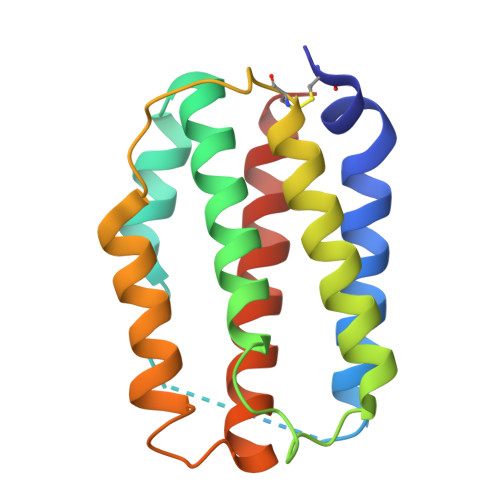Structural and Functional Characterization of a Fish Type I Subgroup d IFN Reveals Its Binding to Receptors.
Guan, Y., Chen, J., Guan, H., Chen, T.T., Teng, Y., Wei, Z., Li, Z., Ouyang, S., Chen, X.(2024) J Immunol 212: 1207-1220
- PubMed: 38345351
- DOI: https://doi.org/10.4049/jimmunol.2300651
- Primary Citation of Related Structures:
7WZ5, 8IRQ - PubMed Abstract:
Teleost fish type I IFNs and the associated receptors from the cytokine receptor family B (CRFB) are characterized by remarkable diversity and complexity. How the fish type I IFNs bind to their receptors is still not fully understood. In this study, we demonstrate that CRFB1 and CRFB5 constitute the receptor pair through which type I subgroup d IFN (IFNd) from large yellow croaker, Larimichthys crocea, activates the conserved JAK-STAT signaling pathway as a part of the antiviral response. Our data suggest that L. crocea IFNd (LcIFNd) has a higher binding affinity with L. crocea CRFB5 (LcCRFB5) than with LcCRFB1. Furthermore, we report the crystal structure of LcIFNd at a 1.49-Å resolution and construct structural models of LcIFNd in binary complexes with predicted structures of extracellular regions of LcCRFB1 and LcCRFB5, respectively. Despite striking similarities in overall architectures of LcIFNd and its ortholog human IFN-ω, the receptor binding patterns between LcIFNd and its receptors show that teleost and mammalian type I IFNs may have differentially selected helices that bind to their homologous receptors. Correspondingly, key residues mediating binding of LcIFNd to LcCRFB1 and LcCRFB5 are largely distinct from the receptor-interacting residues in other fish and mammalian type I IFNs. Our findings reveal a ligand/receptor complex binding mechanism of IFNd in teleost fish, thus providing new insights into the function and evolution of type I IFNs.
- State Key Laboratory of Mariculture Breeding, Key Laboratory of Marine Biotechnology of Fujian Province, College of Marine Sciences, Fujian Agriculture and Forestry University, Fuzhou, China.
Organizational Affiliation:
















